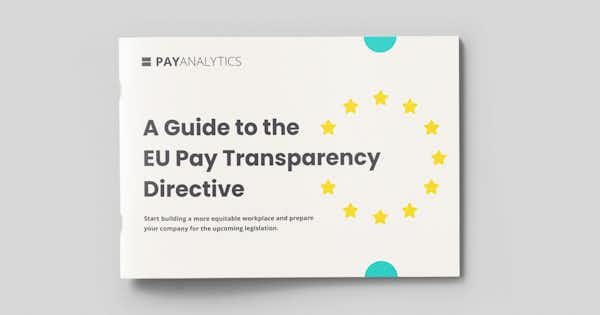Guida alla certificazione della parità di genere in Italia | Scarica il nostro e-book gratuito
Misura

Analisi dell'equità retributiva
L'equità retributiva aiuta a chiarire le strutture retributive identificando i fattori che determinano la retribuzione per poter assumere decisioni informate e avanzare nella giusta direzione.
Panoramica delle funzionalità del prodotto
Raggiungi gli obiettivi di equità retributiva con il software PayAnalytics progettato per essere fruibile con una configurazione minima con il supporto di video tutorial e di un’intuitiva documentazione.
Analisi dell'equità retributiva
Scopri i fattori che influenzano la retribuzione per prendere decisioni consapevoli.
Confronto basato sul valore
Confronta i diversi valori in base al principio della parità di retribuzion per lavori di pari valore.
Analisi del personale
Esamina e migliora la diversità, concentra in modo efficace gli sforzi di inclusione nella tua organizzazione.
Azioni di riparazione
Ottieni raccomandazioni personalizzare per colmare i divari retributivi in base alle esigenze e al budget della tua organizzazione.
Report
Strumenti essenziali per soddisfare le normative globali e report personalizzabili per la leadership.
Assistente retribuzioni
Contribuisci a promuovere un ambiente di lavoro senza pregiudizi garantendo decisioni corrette in materia di retribuzione.
Gestione di dati
Affina facilmente i dati importati in PayAnalytics con correzioni, modifiche e aggiunte, garantendo accuratezza e visibilità.
Valutazione del lavoro
Crea strutture retributive oggettive, confronta ruoli diversi sulla base dei valori dell’organizzazione.
Controlli degli accessi utente
Controlli granulari degli accessi, perché gli utenti hanno diverse esigenze di accesso ai dati.

Siete pronti per la direttiva UE? Abbiamo raccolto un e-book per aiutarvi a conoscere i nuovi requisiti.
Panoramica delle risorse
Abbiamo messo a punto un Centro Competenze per aiutartia orientarti tra equità retributiva, DEI e analisi della forza lavoro. Include articoli, e-book scaricabili, podcast e molto altro.
Guide ed e-book
Esplora le nostre guide per consigli pratici sull’equità sul posto di lavoro. Sono disponibili sotto forma di articoli di approfondimento ed e-book scaricabili.
Articoli e blog
Rimani informato su equità retributiva, trasparenza, correttezza sul posto di lavoro, strategie di comunicazione e trend attuali.
Normativa locale vigente
Rimani aggiornato sull’evoluzione del panorama legale e scopri quali sono le normative applicabili.
Il podcast caffé del venerdì
Le ultime novità in materia di equità retributiva in soli 8 minuti, a venerdì alterni, con Margét e Henrike.
Storie di successo dei clienti
Scopri come le aziende hanno colmato il divario retributivo con PayAnalytics.

PayAnalytics acquisita da beqom
PayAnalytics ha annunciato l'acquisizione da parte di beqom, azienda leader nelle soluzioni di total compensation e performance management.
Chi siamo
Crediamo che la retribuzione non sia solo numero. Il nostro software si basa su oltre un decennio di ricerca e sviluppo da parte di professori pluripremiati, esperti di retribuzione e ingegneri.
Carriere
Unisciti al nostro team appassionato e altamente qualificato. Siamo pionieri nel nostro campo e aiutiamo le aziende a creare ambienti di lavoro equi.
Notizie
Gli ultimi aggiornamenti sull'azienda, come eventi, notizie sui clienti, comunicati stampa e molto altro.
Risorse del marchio
Una panoramica del nostro marchio, dei premi e della nostra storia. Qui è possibile scaricare le risorse e le foto del marchio.
Partenariati
Collaboriamo con diversi partner per promuovere la trasparenza e l'equità nelle pratiche retributive. Esplora le opportunità di partnership.
Servizi di consulenza
Servizi di consulenza personalizzati per l’implementazione dell’equità retributiva, progettati per integrare e valorizzare l’uso del nostro software.
Panoramica delle funzionalità del prodotto
Raggiungi gli obiettivi di equità retributiva con il software PayAnalytics progettato per essere fruibile con una configurazione minima con il supporto di video tutorial e di un’intuitiva documentazione.
Analisi dell'equità retributiva
Scopri i fattori che influenzano la retribuzione per prendere decisioni consapevoli.
Confronto basato sul valore
Confronta i diversi valori in base al principio della parità di retribuzion per lavori di pari valore.
Analisi del personale
Esamina e migliora la diversità, concentra in modo efficace gli sforzi di inclusione nella tua organizzazione.
Azioni di riparazione
Ottieni raccomandazioni personalizzare per colmare i divari retributivi in base alle esigenze e al budget della tua organizzazione.
Report
Strumenti essenziali per soddisfare le normative globali e report personalizzabili per la leadership.
Assistente retribuzioni
Contribuisci a promuovere un ambiente di lavoro senza pregiudizi garantendo decisioni corrette in materia di retribuzione.
Gestione di dati
Affina facilmente i dati importati in PayAnalytics con correzioni, modifiche e aggiunte, garantendo accuratezza e visibilità.
Valutazione del lavoro
Crea strutture retributive oggettive, confronta ruoli diversi sulla base dei valori dell’organizzazione.
Controlli degli accessi utente
Controlli granulari degli accessi, perché gli utenti hanno diverse esigenze di accesso ai dati.
Panoramica delle risorse
Abbiamo messo a punto un Centro Competenze per aiutartia orientarti tra equità retributiva, DEI e analisi della forza lavoro. Include articoli, e-book scaricabili, podcast e molto altro.
Guide ed e-book
Esplora le nostre guide per consigli pratici sull’equità sul posto di lavoro. Sono disponibili sotto forma di articoli di approfondimento ed e-book scaricabili.
Articoli e blog
Rimani informato su equità retributiva, trasparenza, correttezza sul posto di lavoro, strategie di comunicazione e trend attuali.
Normativa locale vigente
Rimani aggiornato sull’evoluzione del panorama legale e scopri quali sono le normative applicabili.
Il podcast caffé del venerdì
Le ultime novità in materia di equità retributiva in soli 8 minuti, a venerdì alterni, con Margét e Henrike.
Storie di successo dei clienti
Scopri come le aziende hanno colmato il divario retributivo con PayAnalytics.
Chi siamo
Crediamo che la retribuzione non sia solo numero. Il nostro software si basa su oltre un decennio di ricerca e sviluppo da parte di professori pluripremiati, esperti di retribuzione e ingegneri.
Carriere
Unisciti al nostro team appassionato e altamente qualificato. Siamo pionieri nel nostro campo e aiutiamo le aziende a creare ambienti di lavoro equi.
Notizie
Gli ultimi aggiornamenti sull'azienda, come eventi, notizie sui clienti, comunicati stampa e molto altro.
Risorse del marchio
Una panoramica del nostro marchio, dei premi e della nostra storia. Qui è possibile scaricare le risorse e le foto del marchio.
Partenariati
Collaboriamo con diversi partner per promuovere la trasparenza e l'equità nelle pratiche retributive. Esplora le opportunità di partnership.
Servizi di consulenza
Servizi di consulenza personalizzati per l’implementazione dell’equità retributiva, progettati per integrare e valorizzare l’uso del nostro software.

Articoli e blog
Qui troverete una raccolta completa di articoli dedicati alla promozione dell'equità sul posto di lavoro, della trasparenza retributiva e delle pratiche di diversità, equità e inclusione (DEI). Dai consigli pratici per orientarsi tra le leggi sull'equità retributiva nei diversi Paesi alle analisi approfondite sul calcolo del divario retributivo di genere e sui benefici delle pratiche di retribuzione equa per l'attrazione e la fidelizzazione dei talenti, le nostre risorse sono pensate per sostenere le organizzazioni e gli individui impegnati a compiere progressi significativi verso l'uguaglianza sul posto di lavoro.
- Articolo
Over the last several years, Portugal has strengthened its pay equity laws. They emphasize transparency, and employers with gender pay gaps may be asked to create a pay equity evaluation plan. This short article provides information to help employers in Portugal be prepared and proactive.
- Articolo
Japan has the largest gender pay gap of any G7 nation. To promote workplace equality, keep women in the labor force after childbirth, and increase advancement opportunities, the country recently made changes to its pay gap reporting requirements.
- Articolo
PayAnalytics’ new Workplace Equity feature helps organizations move beyond equity in pay alone. This feature helps companies analyze diversity and representation among current employees, new hires, and employees who exit the organization, and it looks for demographic differences in who receives raises and promotions.
- Articolo
- Equità retributiva
In 2023, Washington State expanded its pay transparency requirements by creating the Equal Pay and Opportunities Act (EPOA). Rather than disclosing a job’s minimum pay when making an applicant a job offer, the EPOA requires employers to disclose pay ranges in the job posting. In 2025, an amendment was passed to give employers a short window to correct noncompliant postings, to reduce statutory damages for noncompliance, and to clarify the wage information required in postings.
- Articolo
In summer 2022, Ireland implemented a far-reaching pay equity legislation, the Gender Pay Gap Information Act 2021. This legislation requires employers to begin reporting on their gender pay gaps. Companies will need to report differences in the mean and median pay between male and female employees. And if there’s a pay disparity, the company will need to provide a written explanation for it and outline any steps planned to close the gap.
- Articolo
As pay transparency laws continue to gain traction across the US, California employers are getting ready to comply with the state’s new pay reporting and pay disclosure law. It was signed by Governor Newsom on September 27, 2022.
- Articolo
PayAnalytics looks back on a productive 2022. We rolled out several new features to support customers on their pay equity journeys, and we celebrated big milestones for several of our customers. In addition, our team presented at conferences and published their research to promote pay equity worldwide.
- Articolo
Companies hiring in New York City have been changing the way they advertise job openings in response to the new pay transparency law. The New York City pay transparency law's effective date was November 1, 2022, and since then, companies with four or more employees must post the pay range for every job posting. The law covers all NYC-based companies. It also covers companies beyond city limits posting remote jobs that may be filled by NYC-based workers.
- Articolo
Nel panorama attuale, in cui organizzazioni e governi cercano soluzioni per garantire la parità retributiva, i divari retributivi demografici sono una questione di crescente importanza. Con l’espressione "divario retributivo" ci si riferisce regolarmente a due concetti. Qual è la differenza tra il divario retributivo rettificato e il divario retributivo non rettificato?
- Articolo
At PayAnalytics, we often talk about equal pay for work of equal value. Canada’s Pay Equity Act, implemented August 2021, takes a unique approach to achieving this objective. Typically, pay equity requirements focus on how men and women doing similar jobs are paid, but Canada now focuses on the value of the job to the employer.
- Articolo
Last week, our founders David Anderson and Margret Bjarnadottir presented their academic work at the WorldatWork Workplace Equity Forum 2022 in Austin, Texas.
- Articolo
"With the right tools, supported with the right data, we can bring about workplace transformation and pay equity."
In the latest issue of Dynamic Magazine, our founder Margrét shares valuable insights for leaders using data analytics or AI on their pay equity journeys.
Iscriviti alla nostra newsletter
La nostra newsletter tratta argomenti come equità retributiva, retribuzione e benefits, DEI (diversità, equità e inclusione) e modifiche legislative, nonché notizie sulla nostra azienda e aggiornamenti software.











